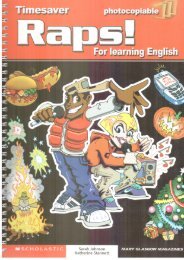English_Book_2-Teacher_300913
English_Book_2-Teacher_300913
English_Book_2-Teacher_300913
Create successful ePaper yourself
Turn your PDF publications into a flip-book with our unique Google optimized e-Paper software.
TEACHER’S NOTESProject 2 A snapshot of a field trip• If students have access to the computer and theInternet at school or at home, create a messageboard for the class beforehand. Instruct studentson how to use it to post questions, ideas, andopinions. You could also have a short lesson onhow to attach photos, if helpful. You may want toassign the actual message writing or posting onthe virtual message board as homework.• If Internet access is not available, you can createan actual class message board on one wall of theclassroom where students can pin or tape theirsuggestions and replies. Alternately, you couldhave students pass their suggestions to otherstudents in the class for comment.• Introduce the activity by asking students if theyhave ever gone on a field trip. Elicit details abouttheir trips by asking questions; for example, Wheredid you go? How did you get there? What did you seeor do there?• Tell students to think about a place that theywant to go for a field trip. They will write a fewparagraphs and choose pictures or photos to gowith these paragraph. Then each student will posthis or her idea for a field trip for everyone else toread and comment on.• Have students look at the photos in the book.Elicit or give the word for this particular place(aquarium) and words for the animals shown inthe photos (dolphin, frog, shark).• Ask volunteers to read the instructions and sampleparagraphs aloud for each step of the project.Point out the emoticons and acronyms and reviewtheir meanings. Tell students they can choose theemoticons and acronyms that they want to put intheir messages and comments.• Give students time to think about their field tripideas and make notes. Circulate and help withvocabulary. You may want to set aside class timefor students to do research on the Internet or inbooks and magazines.• Have students write their first drafts. You maywant to assign this as homework and havestudents do more research at home.• When students have finished, tell them toexchange their first-draft papers with a classmateand edit each other’s work. Have them use thePeer editing checklist on page 138.• Circulate and assist the students. Help drawstudents’ attention to serious errors and parts ofthe text that could be expanded, clarified, edited,or improved.• In class or as homework, ask students to writea second draft of their paragraphs using thecomments and suggestions of their partners. Theyshould also collect the photos they plan to includeor make drawings to illustrate their projects.• Have students post their ideas on the messageboard. If they are posting it on the Internet,allow time for students to read and reply to theirclassmates’ ideas. You may want to assign thereading and responding portion as homework. Ifstudents are posting their ideas on the messageboard on the classroom wall, or are passing theirsuggestions around the room, allow time forstudents to read their classmates’ ideas, write theircomments and replies, and post them.This is a Home/School connection activity.• After other students have commented on thefield trip ideas, suggest that students share theirwork with their families. Tell them to read aloudand explain their field trip plans and classmates’comments.T51Postcards_splitB_TE1_U05.indd T512/27/07 10:21:21 AM




